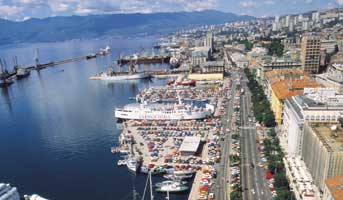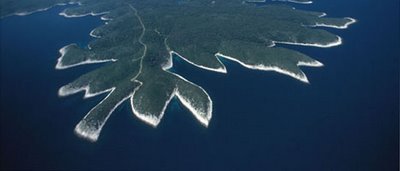VINELAND
DNA sleuths find the 'original Zin'Coveted 'Californian' grape's genetic fingerprint traced back to its source By WILLIAM CAMPBELL

In August, the California state legislature passed a bill recognizing Zinfandel as the state's official "historical wine." This caused an immediate outcry among passionate Pinot fans, and sent waves of astonishment rippling through the upper echelons of Napa Valley's otherwise staid Cabernet dynasties.
Many people laughed, but the case for recognizing Zinfandel was a strong one.
First brought to the state during the 1849 Gold Rush, by the 1860s it had already become a coveted grape, presumably because when Zinfandel is grown in California's Mediterranean climate it produces a fruity, spicy, high-alcohol wine that is literally ready to drink straight from the barrel. By the start of the Prohibition era in 1920, Zinfandel had actually become the most widely planted grape in California.
Although it accounts for only 9.8 percent of the state's crush today (ceding to Cabernet and Chardonnay), Zinfandel is grown almost nowhere else in the world, leading many to still consider it "California's own."
The controversy was quite spirited, but ultimately proved moot when Governor Arnold Schwarzenegger vetoed the bill, claiming that it would be unfair to single out any particular grape, despite Zinfandel's deep historical roots in the state.
While this tempest in a wine glass quickly blew over, we were left wondering where Zinfandel came from, since all sides in the debate acknowledged that the grape certainly wasn't a native of the state.
To help answer this question, we spoke with Carole Meredith, professor emeritus at University of California, Davis. Widely know in the wine world as "Dr. DNA" for her work in vine genetics, Meredith explained that cracking the origin of Zinfandel required a combination of good old-fashioned detective work and groundbreaking genetic research.
The first clue to Zinfandel's origins came in 1967, when Austin Goheen, a plant pathologist at UC Davis, was vacationing in Italy. While drinking a local Puglian wine known as Primativo, Goheen noted its similarity to Zinfandel. He had Primativo vine cuttings propagated in the Davis research vineyards, and, in 1971, a group of ampelographers (botanists who identify grape varietals based on leaf shape and other physical characteristics) pronounced Zinfandel and Primativo to be indeed one and the same.
The only problem was that Primativo was well-documented as itself being a nonnative varietal that had arrived in Italy long after Zinfandel had already been established in California.
So California Zinfandel and Italian Primativo were both the same grape, but neither was native, which suggested a third, presumably European, country of origin. But which country?
In the late '70s and early '80s, Croatian researchers began to lobby UC Davis with samples of Plavac Mali, the grape that was consistently producing the best red wines in Croatia's Dalmatian Coast region.
Their bold claim was that this grape was the long-lost "original Zin." While there were indeed many similarities, there were also enough subtle differences that a "not proven" verdict was given, and the question was left open for future research.
In ensuing decades, two enormous breakthroughs were made in the field of genetic research. The first was the discovery that within the DNA of every animal and plant (including humans and grapevines), there are certain sites where the DNA subunits simply repeat themselves over and over again.
More importantly, the number of these random "simple sequence repeats" (known as SSRs) at each site varies from person to person, or grape variety to grape variety (grapes are propagated by taking cuttings from one vine to create another, so all Zinfandel vines, for example, are genetically identical).
To help understand this, imagine that two vinyl Led Zeppelin albums are found in an attic. The first is scratched in such a way that there is a single loud "pop" heard in the pause between the lyrics "a stairway" and "to heaven." Now imagine that the second album is in slightly worse shape, and that there are three sharp "pops" heard in exactly the same part of the song.
If both albums were converted to MP3 files and uploaded to pirate music-sharing sites, they would then be copied all over the world. However, even many years and hundreds of generations later (since MP3 copying is like making a perfect clone), it would still be possible to count the number of "pops" in that particular part of the lyric sequence and determine whether the file you were listening to originated from the first or the second album.
Back on the DNA sequence, there are thousands of sites where SSRs are found between two otherwise uniquely identifiable spots, which makes it possible to isolate a particular one for each person and count the number of repeats which that individual has at the site. The number of random repeats a person has at one site, which we will call "site A," ranges from 1 to 200. Therefore, I would have a one-in-200 chance of having the same number of repeats at "site A" as my best friend. The odds of my friend and I independently matching at a second, unrelated site are also 1 in 200, so the odds of us each having the same number of repeats at both "site A" and "site B" would be only one in 40,000. Include 13 different sites in the analysis, as the FBI does in its CODIS forensic DNA database, and the odds of two different people having the same patterns would rise to one-in-a- billion-trillion (other than for identical twins, who would match exactly).
The second major breakthrough in the DNA detective game was the creation of a technique called polymerase chain reaction (PCR) that allows scientists to effectively cut out a specific piece of DNA -- a piece that in our case would include one of the repeating sequences mentioned above.
Since these repeating sequences are repetitions of charged particles, my "site A" snippet is likely to have a different total charge from that of my friend's. These charges are measured in an elegant but decidedly low-tech manner.
After being amplified in a PCR machine, my DNA snippets and my friend's are each put in different lanes at the edge of a gel-filled Petri dish. The dish is then placed in an electrostatic field, which causes the differently charged DNA snippets to race across the gel at different speeds.
After a certain period of time, the gel is chemically "fixed" (like developing a photograph) and the positions of the two samples show whether the two DNA samples, at least at the site being examined, are matches or not.
When a baby is conceived, or a new vine species is created by cross-pollination, each parent contributes half the DNA, which means that the above technique can be used to prove parent/child links as well.
After years of painstaking DNA sequencing, this is exactly what Meredith's UC Davis team found -- Plavac Mali was not Zinfandel, but was instead the result of a cross between Zinfandel and an obscure Croatian grape known as Dobricic.
Finding both a parent and child in Croatia heavily hinted that the heritage of the missing parent would be Croatian as well, but for years the research teams returned from the fields with bushels of samples, only to find that none of them tested out.
Finally, in 2001, the team visited an ancient vineyard of mixed vines planted high up the Dalmatian Coast and found nine intriguing-looking specimens of a nearly extinct varietal known locally as Crljenak Kastelanski.
The tests came back as a perfect match -- at long last the origin of Zinfandel had been found. Of course, one couldn't help lament that Zinfandel wasn't revealed to have had an Austrian connection, or it just might be California's official state grape today.
For more background on vine DNA, or other comments, please contact vinelandtalk@hotmail.com
Friday, Nov. 10, 2006
The Japan Times
 This winter travel season promises to be a bumpy one, as flight delays continue to increase and more ticketed passengers are turned away at the gate. Airlines almost always book more passengers on a given flight than a plane can accomodate. The odds of being bumped from a flight are greater that they've been in years. Learn what you can get for giving up your seat. Know your rights and beware of airlines bearing gifts.
This winter travel season promises to be a bumpy one, as flight delays continue to increase and more ticketed passengers are turned away at the gate. Airlines almost always book more passengers on a given flight than a plane can accomodate. The odds of being bumped from a flight are greater that they've been in years. Learn what you can get for giving up your seat. Know your rights and beware of airlines bearing gifts. 










